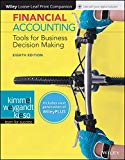
Financial Accounting: Tools for Business Decision Making, 8e WileyPLUS (next generation) + Loose-leaf
8th Edition
ISBN: 9781119491057
Author: Paul D. Kimmel, Jerry J. Weygandt, Donald E. Kieso
Publisher: Wiley (WileyPLUS Products)
expand_more
expand_more
format_list_bulleted
Question
Chapter 6, Problem 14Q
To determine
Cost flow assumptions: Cost flow assumptions can be referred to as method which determines the flow of costs when an inventory is sold. Instead of keeping a track record for cost of each product sold, a company adopts these methods and identifies which units were sold. It differs from specific identification method because the actual physical movement of goods may be unrelated to the flow of costs.
To Explain: Whether Mr. O is correct.
Expert Solution & Answer
Want to see the full answer?
Check out a sample textbook solution
Students have asked these similar questions
Can you solve this general accounting problem with appropriate steps and explanations?
Please provide the correct answer to this financial accounting problem using accurate calculations.
Can you solve this general accounting question with accurate accounting calculations?
Chapter 6 Solutions
Financial Accounting: Tools for Business Decision Making, 8e WileyPLUS (next generation) + Loose-leaf
Ch. 6 - The key to successful business operations is...Ch. 6 - Prob. 2QCh. 6 - What is just-in-time inventory management? What...Ch. 6 - Prob. 4QCh. 6 - Prob. 5QCh. 6 - Prob. 6QCh. 6 - Prob. 7QCh. 6 - Prob. 8QCh. 6 - What is the major advantage and major disadvantage...Ch. 6 - The selection of an inventory cost flow method is...
Ch. 6 - Which assumed inventory cost flow method: (a)...Ch. 6 - Prob. 12QCh. 6 - Prob. 13QCh. 6 - Prob. 14QCh. 6 - Prob. 15QCh. 6 - Prob. 16QCh. 6 - Prob. 17QCh. 6 - Prob. 18QCh. 6 - Why is it inappropriate for a company to include...Ch. 6 - Prob. 20QCh. 6 - Prob. 21QCh. 6 - Prob. 22QCh. 6 - When perpetual inventory records are kept, the...Ch. 6 - How does the average-cost method of inventory...Ch. 6 - Prob. 25QCh. 6 - Prob. 6.1BECh. 6 - Prob. 6.2BECh. 6 - Prob. 6.3BECh. 6 - Prob. 6.4BECh. 6 - Prob. 6.5BECh. 6 - Prob. 6.6BECh. 6 - Prob. 6.7BECh. 6 - Prob. 6.8BECh. 6 - Prob. 6.9BECh. 6 - Prob. 6.10BECh. 6 - Prob. 6.11BECh. 6 - Prob. 6.1DIECh. 6 - Prob. 6.2DIECh. 6 - Prob. 6.3ADIECh. 6 - Prob. 6.3BDIECh. 6 - Prob. 6.1ECh. 6 - Prob. 6.2ECh. 6 - Prob. 6.3ECh. 6 - Prob. 6.4ECh. 6 - Prob. 6.5ECh. 6 - Prob. 6.6ECh. 6 - Prob. 6.7ECh. 6 - Prob. 6.8ECh. 6 - Prob. 6.9ECh. 6 - Prob. 6.10ECh. 6 - Prob. 6.11ECh. 6 - Prob. 6.12ECh. 6 - Prob. 6.13ECh. 6 - Inventory data for Jeters Company are presented in...Ch. 6 - Prob. 6.15ECh. 6 - Prob. 6.16ECh. 6 - Prob. 6.17ECh. 6 - Prob. 6.1APCh. 6 - Prob. 6.2APCh. 6 - Prob. 6.3APCh. 6 - Prob. 6.4APCh. 6 - Prob. 6.5APCh. 6 - Prob. 6.6APCh. 6 - Prob. 6.7APCh. 6 - Prob. 6.8APCh. 6 - Prob. 6.9APCh. 6 - Prob. 6.1CACRCh. 6 - Prob. 6.1EYCTCh. 6 - Prob. 6.2EYCTCh. 6 - Prob. 6.3EYCTCh. 6 - Prob. 6.4EYCTCh. 6 - The July 15, 2010, edition of CFO.com contains an...Ch. 6 - Prob. 6.7EYCTCh. 6 - Prob. 6.8EYCTCh. 6 - Prob. 6.9EYCTCh. 6 - Prob. 6.10EYCTCh. 6 - Prob. 6.11EYCTCh. 6 - Prob. 6.1IFRSCh. 6 - Prob. 6.2IFRSCh. 6 - Prob. 6.3IFRS
Knowledge Booster
Learn more about
Need a deep-dive on the concept behind this application? Look no further. Learn more about this topic, accounting and related others by exploring similar questions and additional content below.Similar questions
- Can you explain this financial accounting question using accurate calculation methods?arrow_forwardCan you help me solve this financial accounting question using valid financial accounting techniques?arrow_forwardPlease provide the accurate answer to this financial accounting problem using appropriate methods.arrow_forward
- Please provide the solution to this general accounting question using proper accounting principles.arrow_forwardI need help finding the accurate solution to this general accounting problem with valid methods.arrow_forwardDetermine the price of a $1.3 million bond issue under each of the following independent assumptions: Maturity 10 years, interest paid annually, stated rate 8%, effective (market) rate 10%. Maturity 10 years, interest paid semiannually, stated rate 8%, effective (market) rate 10%. Maturity 10 years, interest paid semiannually, stated rate 10%, effective (market) rate 8%. Maturity 20 years, interest paid semiannually, stated rate 10%, effective (market) rate 8%. Maturity 20 years, interest paid semiannually, stated rate 10%, effective (market) rate 10%.arrow_forward
- If total assets increase while liabilities remain unchanged, equity must: A) IncreaseB) DecreaseC) Remain the sameD) Be negativearrow_forwardNo chatgpt!! Which of the following is an intangible asset? A) InventoryB) CopyrightC) EquipmentD) Accounts Receivablearrow_forwardWhich of the following is an intangible asset? A) InventoryB) CopyrightC) EquipmentD) Accounts Receivableno aiarrow_forward
arrow_back_ios
SEE MORE QUESTIONS
arrow_forward_ios
Recommended textbooks for you
 Cornerstones of Cost Management (Cornerstones Ser...AccountingISBN:9781305970663Author:Don R. Hansen, Maryanne M. MowenPublisher:Cengage Learning
Cornerstones of Cost Management (Cornerstones Ser...AccountingISBN:9781305970663Author:Don R. Hansen, Maryanne M. MowenPublisher:Cengage Learning

Cornerstones of Cost Management (Cornerstones Ser...
Accounting
ISBN:9781305970663
Author:Don R. Hansen, Maryanne M. Mowen
Publisher:Cengage Learning
Why do we need accounting?; Author: EconClips;https://www.youtube.com/watch?v=weCXE2wIl90;License: Standard Youtube License